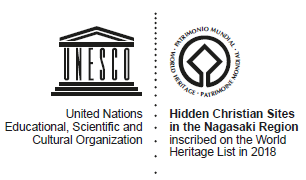Component
 Sakitsu Village in Amakusa
Sakitsu Village in Amakusa
(Ⅱ) Formation of the tradition of continuing the Christian faith

 (Ⅰ) Beginning of the absence of missionaries and hiding of Christians
(Ⅱ) Hidden Christians' endeavours to continue their religious faith
(Ⅲ) Hidden Christians' endeavours to maintain their religious communities
(Ⅳ) The transitional phase triggered by contact with missionaries, leading to the end of Hidden Christians' hiding
(Ⅰ) Beginning of the absence of missionaries and hiding of Christians
(Ⅱ) Hidden Christians' endeavours to continue their religious faith
(Ⅲ) Hidden Christians' endeavours to maintain their religious communities
(Ⅳ) The transitional phase triggered by contact with missionaries, leading to the end of Hidden Christians' hiding












 |
In Sakitsu, Hidden Christians were able to continue practising their faith over time by substituting everyday items used in daily life and work for Christian devotional objects. |
-
Animation Video (Sakitsu Village in Amakusa)
Sakitsu Village in Amakusa is one of the four components that are representative villages demonstrating what the Hidden Christians venerated to continue their secret faith. Hidden Christians in Sakitsu continued their religious faith in a unique way, substituting everyday items that were used in their daily life and work in the fishing village for Christian devotional tools during the ban on Christianity. They venerated statues of the Japanese traditional deities Daikokuten and Ebisu as Deus, the God of the Christian faith, and abalone shells that had special significance as their mother-of-pearl patterns were associated with the Virgin Mary. After the lifting of the ban, the Hidden Christians in Sakitsu rejoined the Catholic Church. Beside a Shinto shrine where they had secretly offered prayers during the ban, they built a Catholic church, marking the end of their hiding.
Basic information



| Designation title as cultural assets | Location | Designation category | Year of designation |
|---|---|---|---|
| Cultural Landscape of Sakitsu and Imatomi in Amakusa | Amakusa City, Kumamoto Prefecture | Important Cultural Landscape selected by the national government | Firstly in 2011 and additionally in 2012 |
Access
>Sakitsu Village in Amakusa(”Hidden Christian Sites in the Nagasaki Region” Information Centre)
※A new window opens.

































 Remains of Hara Castle
Remains of Hara Castle Kasuga Village and Sacred Places in Hirado
Kasuga Village and Sacred Places in Hirado Kasuga Village and Sacred Places in Hirado
Kasuga Village and Sacred Places in Hirado Sakitsu Village in Amakusa
Sakitsu Village in Amakusa Shitsu Village in Sotome
Shitsu Village in Sotome Ono Village in Sotome
Ono Village in Sotome Villages on Kuroshima Island
Villages on Kuroshima Island Remains of Villages on Nozaki Island
Remains of Villages on Nozaki Island Villages on Kashiragashima Island
Villages on Kashiragashima Island Villages on Hisaka Island
Villages on Hisaka Island Egami Village on Naru Island
Egami Village on Naru Island Oura Cathedral
Oura Cathedral